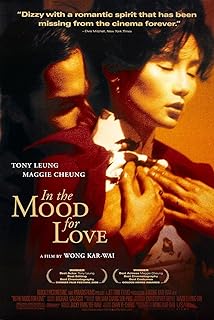花样年华/
![]() 8.1 / 170,498人
98分鐘 | Poland:94分鐘
8.1 / 170,498人
98分鐘 | Poland:94分鐘
編劇: 王家衛
演員: 梁朝偉 張曼玉 潘迪華 Lai Chen Ping Lam Siu

2013-12-21 11:11:21
Sequence Analysis
************這篇影評可能有雷************
One of the thematic presentations in the film In the mood for love is the emotional bonding and struggle between the two protagonists who drown themselves in a sea of nostalgia, and at the same time remain fixated on their loss. The relationship between Su and Chow strangely emerges after discovering the transgression of their husband and wife. Su and Chow cannot help falling for each other while both of them try to keep their distance. The hotel sequence is one of the turning points where they consciously realize their growing feeling but pretend to be blind to it. Such unspoken love is sophisticatedly presented through cinematography, editing, mise-en-scene and sound in this sequence.
The hotel sequence starts from Su’s entrance. Led by a quick medium shot focused on Su’s fast steps, we see the black high heel rush up from the left side of the frame to the right side of the frame while the camera spirals down from the right to the left. At the same time, the hotel receptionist in the shot is out of focus while the spectators can still catch the receptionist’s gaze, which is fully on Su’s figure. Then quickly after the first shot, we are cut into a full shot of Su climbing on the stairs but from an entirely opposite angle. This switch of perspective echoes with the presence of the receptionist: the spectators are now observing Su from the male receptionist’s gaze. Following Su rushing back and forth from upstairs to downstairs, the camera tilts down from a relatively high angle and then tilts up again focusing on Su’s intensely moving steps as she climbs up to the stairs again. In Contrast to the previous scene of Su almost statically sitting in the taxi with very few motions involved, the camera movements of Su rushing up and down to the stairs reflect the anxiety in Su’s inner world, the anxiety that she tries to oppress and neglect. After the medium long shot of Su resting on the top floor, being entirely exhausted, the camera takes us back to the hotel corridor and the stairs, changing in between oppositional perspectives. For example, the first presented image after her pause is the medium front shot of Su’s lower legs walking quickly toward somewhere we do not know. Then immediately the camera changes to a relatively higher angle shooting her from the back in the same corridor, walking to the unknown place. The first part of the sequence also ends up with an opposition that echoes to Su’s entrance into the hotel. The camera follows Su from the upper right position on the stairs, and spirals down to the lower left, and we also see the same receptionist who is out of focus. Though there is no dialogue in the first part of the sequence, the way that camera moves completely expose Su’s inner anxiety through her agitated steps. In addition, the editing in this part also intensifies and doubles up the effects that how Su experiences in that moment and delivers the emotional message to the spectators. There are twelve cuts in the ten seconds sequence. The twelve cuts are structured in a seemingly disjointed, fast-paced way that is parallel to Su’s disjointed, fast-paced mind thoughts and motions. The editing then works invisibly with the camera movements producing a ten seconds chaotic sequence that invites the spectators to experience Su’s dilemma. As Su’s steps speeding up when she runs up and down, she seems to be totally lost in the hotel maze. The scenes of disjointed spaces with Su’s presences suggest that she is searching for something, however no one knows what she is searching for nor her final destination. She travels up and down and runs into the corridor repeatedly, and her emotional monologue which is reflected by her movements are magnified by and the oppositional movement of the camera and the fast tempo editing while the reason that calls Su’s anxiety still remains unrevealed.
This mystery links to the second part of the sequence. The hint begins with a medium shot of Chow looking through the window and smoking. Chow is framed in the position from center to the left. In contrast to the previous part, Chow’s stillness, which is emphasized by the camera, makes him look like a portrait painting. Chow is thinking, and he is also waiting for someone. His melancholy, silent seriousness is first distracted by the rising smoke of his cigarette and later, the knocks on the door. Then the camera takes us to the same corridor that presents in the previous sequence, and we see Su walks out of a room from a distance. This full shot in a fixed angle portrays a crucial moment that connects the external space and internal space through the protagonists』 movements. Su turns around and speaks to somebody in the room, and we hear Chow’s voice. The conversation starts with Chow’s absence on the screen. Then gradually, we see Chow leans out of the room. After a short pause, a close up of Chow abruptly and silently jumps into the screen. He said, 「I did not expect you to come.」 「 We won』t be like them」, Su replies, presented in a close up shot in her half-sided profile. The conversation ends up with a reverse shot of Su’s leaving. Then quickly the spectators are cut into a high angled medium shot of Chow closing the door. Finally, the camera slowly moves backwards while Su walking to the opposite direction of the hotel corridor until she stands still. In this part, the camera moves in a static manner, and the tempo of editing slows down. Each scene lasts longer than it was in the previous part. As a result, Su’s representation is completely different from her image in the beginning of the sequence, which she’s delineated as a nervous, lost woman who runs blindly in the hotel. The chaotic anxiety disappears after Chow’s appearing on the screen. His calmness, silence and stillness that repetitively highlighted by the camera become the remedy to cure Su’s worried look. Though we never have any direct access to Su’s thought, the mystery constructed in the first part finally discloses at the moment Su steps out of Chow’s room. It is clear that the time shift enabled by editing plays a major part for indicating their unspeakable relationship. Immediately jolted by Su’s presence in the corridor after hearing the knocks on the door, what happened inside of the room becomes another mystery. Yet 「We won』t be like them」 seems to be a clear 「confession」, the dichotomy between 「we」 and 「them」, their shadowy spouses is inevitable. Therefore in this sequence, the camera always presents a voyeuristic gaze from a distance, and gives space to the objects surround them emphasizing the 「invisible」 witness of their growing feeling which is supposed to remain 「invisible」 in the claustrophobic social environment they live in.
Mise-en-scène also accounts for a vital part in constructing the 「mood」 for love. For example, the use of color in the sequence metaphorically mirrors the protagonists』 inner voice and desire. In the sequence, the dominant color is red: Su’s red long coat flies like fire while she rushes up to the stairs; the waterfall of red velvet curtain hanging along the hotel hallway and the spiral staircases; and the hallway itself is presented in a warm maroon color. Such eruptions of red illustrate the reclusive desire that undergoes inside of the couple. By placing Su in the space of metaphor, her silent anxiety which shown in the first part of the sequence then drives her into a women who is lost and caged in her own desire that she could not speak. Moreover, together with the color, the physical objects in the set and the artificial lighting in this sequence also constitute a dramatic effect to create a surrealistic space: the wallpaper, the spiral staircase, the supermatistic-checked floor, the careful designed lights which hanging on the ceiling and the wall …these sophisticatedly flamboyant details of décor closely tights to the dream quality of Su and Chow’s veiled love and furthermore foreshadows their unapproachable relationship.
Sound plays a subtle but significant role. There is only diegetic sound in the sequence: the sound of Su’s high heels running and walking in the hotel, the knocks on the door, Su and Chow’s short conversation, and the sound of Chow closing the door. These episodic sound effects not only help progress the episodic narrative, they are also the inner voice of the protagonists. However, what is more important is the silence in between the collage of the sound. The protagonists do not speak much: while Su runs madly in the hotel and anxiously searches for her love, the sound of her high heels speaks for her; while Chow looks out of the window and drowns himself in searching for his emotional loss, the silence speaks for him. In the hotel, the only dialogue we have in the sequence is before Su leaves the room. The conversation between Su and Chow is short and simple but profound at the same time. Driven by the submerged passion, the stoppage and pause in their conversation is central to create a sensuous milieu that encloses these two lost, nostalgic souls and isolates them from the outside world. Therefore the gravity of the silence not merely comes from the protagonists』 own characteristic, it is also brought by their 「mute」 love and hidden desires that both oppressed by the traditional social values and the lovers themselves.

